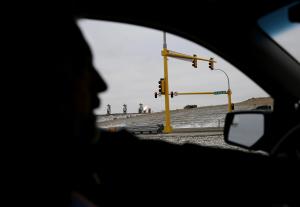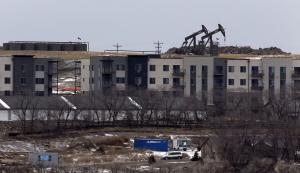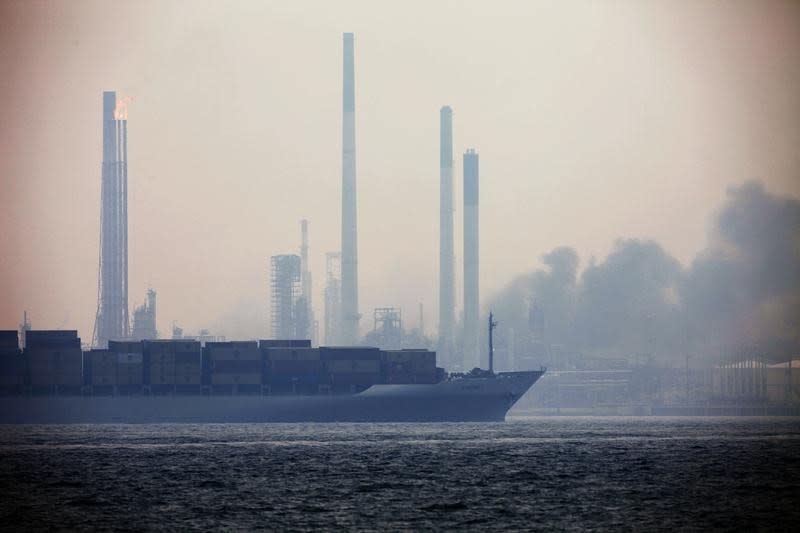WATFORD CITY, N.D. (AP) — Police chief Art Walgren knew how much the oil boom had changed this once-sleepy town when he spotted something that would have been unheard of not long ago: license plates from Sinaloa, Mexico, home to one of the world's most violent drug cartels.
Before, there was little chance police would see cars here from nearly 2,000 miles away. And little reason to worry about out-of-state plates. Now, though, police are scrambling to deal with new kinds of criminal threats and suspicious activity that have cropped up along this frozen prairie.
The gusher of oil and money flowing from the Bakken fields has made policing more demanding and dangerous, forcing small-town officers, county sheriffs and federal agents to confront everything from rowdy bar fights to far-reaching methamphetamine and heroin networks and prostitution rings operating out of local motels.
"It's not Mayberry anymore," says U.S. Attorney Tim Purdon, the state's top federal prosecutor. "Our police and prosecutors are going to have to adapt to keep pace. We have organized criminal gangs selling drugs, sex trafficking and out-of-state flim-flam men coming in. And the cases have become more and more complicated."
Most newcomers to the Bakken — which spans western North Dakota, eastern Montana and part of Canada — move here honestly in search of a new job or, in some cases, a new life. But more people also means more crime, overcrowded jails and overwhelmed police departments, often with relatively inexperienced officers who are constantly racing from call to call.
"What do we need? More people," Purdon says. "We are responding but we need to have more cops, more prosecutors and more judges. We can't expect to move an incredibly large number of cases through the same machinery that's been in effect for the last 20 years."
View gallery

In this Tuesday, Dec. 16, 2014 photo, Watford City Police Chief Art Walgren passes oil wells in his …
Reinforcements are on the way. In November, the FBI announced it will open a permanent office in the Bakken — time and location to be determined — joining other federal agencies devoting more resources to the area. State law enforcement groups also are teaming up with local police to crack down on newly emerging criminal enterprises.
"There used to be a saying that 40 below keeps out the riff-raff," says Steve Kukowski, Ward County sheriff. "That's not true anymore."
Not all crime is on the rise. In North Dakota, the number of murders dropped in 2013, but drug arrests increased nearly 20 percent and robberies were up 29 percent compared with 2012. In Montana, oil patch arrests rose by 80 percent between 2008 and 2012, and drug investigations initiated by the state Department of Justice in that area nearly tripled between 2010 and 2013, according to state Attorney General Tim Fox.
Police aren't just dealing with more drugs, but more calls on everything from reports of suspicious strangers to gunfire. Officers who fielded a call or two a night years ago might now scramble to handle 20, 30 or more. About a third of law enforcement officers surveyed in a 2013 North Dakota State University study of oil patch police reported that fears of crime have increased in their communities since the boom began.
Here in Watford City, the police force has multiplied from just four, including the chief, in 2010 to 19 sworn officers serving a population that could grow to 15,000 by 2017, a nearly tenfold increase since the last census. Even more dramatic: In 2006, there were just 41 calls for service, according to the university study. Last year, there were 7,414.
View gallery

In this Thursday, Dec. 18, 2014 photo, Dickinson Police Chief Dustin Dassinger stands next to patrol …
"It puts a lot of pressure on us," says Walgren, a 25-year police veteran who became chief last spring. "We're so used to trying to maintain that small-town attitude where you always wave at your neighbor and everybody's always your friend. Now, there are more people that you don't know than those that you do."
That changes police strategy. "Before if you had a bunch of thefts, you'd have a handful of most likely suspects — people who were hard-up for money," Walgren explains. "Now it's much more anonymous and you have to go outside the box ... learn new techniques and handle crimes you've never dealt with before."
Watford City is a town in transition. The days of shuttered Main Street storefronts are over. Billboards beckon with job opportunities. Construction cranes are visible from almost any corner of town. Projects worth tens of millions of dollars are planned or in the works, including apartments, a hospital, a high school, two hotels (several have recently opened) and, not surprisingly, a law enforcement center.
Gas flares light the night skies, illuminating pump jacks that nod up and down, like giant birds feeding from the soil. Hulking rigs barrel down newly widened roads. So-called man camps — rows of identical barracks-like housing — have popped up in wind-swept fields just outside town. And workers in hard hats, coats trimmed with reflector tape and mud-caked boots line up in the pre-dawn darkness at the Kum & Go gas station-convenience store for chewing tobacco and coffee.
This is not the Wild West, as some media accounts have suggested, says Walgren, but his officers are navigating a new landscape: For the first time, the department now has two full-time detectives to investigate crimes such as financial fraud, including embezzlements — there have been two bigger-than-ever cases in the last six months. Police conduct training sessions at motels on how to be alert for sex trafficking (cash only is a red flag). And arrests have been made that have indirect ties to the Sinaloa cartel, the chief says.
View gallery

In this Monday, Dec. 15, 2014 photo, a worker walks inside a Ward County complex under construction …
Drugs, a growing problem, are sometimes accompanied by violence. In November, the arrest of a 21-year-old woman who was charged with attempted murder after she allegedly shot a man in the face led to the arrests of three of her associates in a suspected meth and marijuana operation.
"I'm busier than I ever thought I'd be," the chief says. "It's the kind of stuff you don't expect in a small town."
What's happening in Watford City is not atypical.
In Dickinson, nearly 70 miles southeast, a highly visible four-person team patrols the bars on random Friday and Saturday nights to head off brawls that have become increasingly common. Police reported calls were up nearly 45 percent from 2009 to 2014, when there were more than 27,000.
"Some of the North Dakota niceness has left our community," says Dickinson Police Chief Dustin Dassinger. "It's an adjustment, not just for law enforcement but for everyone."
View gallery

In this Wednesday, Dec. 17, 2014 photo, oil pump jacks work behind new construction near Watford Cit …
Being a police officer has become more stressful, says Capt. Joe Cianni, a 21-year veteran. "This department wasn't used to dealing with major crimes involving weapons," he says. "In the past, it used to happen once every four to six months. Now it's once a week."
The hectic pace tends to burn out officers and it's hard to recruit and retain new ones, he adds. Among the reasons: the high cost of living ($80,000 homes before the boom can now sell for $200,000), the remoteness of the city and a perception of North Dakota as a barren place with brutal winters and little else. Other towns say their officers are sometimes lured away to six-figure jobs in the oil fields.
Stretched thin, Dickinson police don't have enough staff to conduct sex stings that result in misdemeanors. Some officers participated in one federal-state-local operation in late 2013 that had to be cut short when authorities ran out of jail space after arresting 11 men, says Purdon, the prosecutor. They'd answered a bogus ad police placed in Backpage.com purporting to offer sex with a 14-year-old girl.
"That's shocking to me," Purdon adds. "It shows a level of demand for sex with underage kids that's really scary. ... You're crazy if you don't think there's a supply out there to match it." He says one man answering the ad wanted to know what was the youngest girl available.
State officials are shifting their resources, too, to pursue a new breed of savvier criminals.
View gallery

In this Monday, Dec. 15, 2014 photo, a Ward County sheriff's deputy monitors jail cells via surv …
In Montana, the state Department of Justice has dispatched veteran agents from the western part of the state to the eastern oil patch region to help younger, less experienced staff, according to Mark Long, the agency's narcotics bureau chief.
Local drug traffickers have been pushed aside by organized West Coast gangs and groups such as the Sinaloa cartel that "bring in everything they need," Long explains. "They're pretty well-educated on law enforcement techniques. It's 'been there, done that.' We have to get out ahead of the curve."
Long also says small-town police ask his agency for training, but they're more interested in patrol-related issues such as stopping bar fights than they are in investigating major crimes. "They're just trying to stem the tide of that day-to-day stuff. ... This isn't a knock on these guys," he says. "They've never had to deal with some of these problems. Some of these counties haven't had a homicide in 20 years. Now they're getting them."
Even in larger cities that have encountered major crimes, there are increasing dangers.
In Williston, N.D., the epicenter of the oil boom, two men have been killed in recent years outside two downtown strip clubs — one in a beating, the other a shooting.
View gallery

In this Tuesday, Dec. 16, 2014 photo, Watford City Police Chief Art Walgren drives his patrol vehicl …
The mayor recently lamented that Williston was devoting 80 percent of its late-night policing to the side-by-side clubs, taking away needed resources from other parts of the city. And last month, the clubs lost their liquor licenses for 60 days — the second suspension in two years.
In December, Jonathan Horvath was sentenced to life without parole for the 2013 fatal club shooting.
It was the harshest sentence District Judge David Nelson had ever imposed in two decades of handling felonies. He'd always vowed, he says, never to take such an extreme step, believing an inmate can change over decades behind bars. But in this case, the judge says he wanted to reassure the victim's family that Horvath would never be freed.
"I don't really care what Mr. Horvath is like in 25 years," Nelson adds. "If he's found the Lord, he can preach in prison."
After handling perhaps two murder cases in the previous 20 years, Nelson says this one was among five he's had in the last 13 months, all but one involving newcomers. Horvath had come from Idaho to North Dakota looking for work. "He'd been there five days and committed murder," the judge says, "and now the state of North Dakota is going to pay how much for him for the rest of his life?"
View gallery
This Monday, Dec. 15, 2014 photo shows construction of a Ward County complex which includes a courth …
In Ward County, two hours east of Williston, the sheriff is facing a problem that exists in many parts of the oil patch: an overcrowded jail. In October, state corrections officials ordered the county to find a solution after more than 150 inmates had been double-bunked in the 104-bed jail. Since then, inmates have been transferred as far as 110 miles away, which will cost the county more than $700,000 this year, Kukowski says.
To free up space, people charged with petty theft, disorderly conduct and other low-level crimes are no longer jailed and instead are required to sign a pledge to appear in court. "We have no room at the inn," Kukowski says, noting the jail was built 30 years ago when the population was half of what it is now.
Next month, voters will be asked to approve up to $41 million in borrowing to renovate the courthouse and expand the jail by 100 cells — a recent plan to add 50 cells is already outdated.
"It's extremely frustrating," Kukowski says. "I never believed we would be facing some of the issues we're facing now ... The times have changed for those of us living in rural America. ... We absolutely have a lot of the same problems that inner cities have. We just have to deal with them."
___
Sharon Cohen, a Chicago-based national writer, can be reached at scohen@ap.org.






















